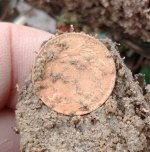pinenut
Bronze Member
- Mar 15, 2016
- 1,024
- 1,363
- Detector(s) used
- Various Tesoro - mostly Bandido II μMAX
- Primary Interest:
- Metal Detecting
Hey folks, thought I'd start off by asking how to determine when and where my local beaches will not be "sanded in".
Just went out with my new Tesoro Sand Shark yeasterday (with the full crowd there - was a family outing), and didn't find any "erosion" happening, and no great areas to search. While the detector worked perfectly without any falsing and I dug a bobby pin and a few bottle caps at least a foot down, it seems as if there weren't any targets on that beach.. It was clean!
I was swinging in the wet sand, and out in up to knee-deep water.
I live up in the mountains now about 2-3 hours from the beaches, so I can't get there to hunt but once or twice a week.
So, how can I determine when and where to do wet beach detecting?
Just went out with my new Tesoro Sand Shark yeasterday (with the full crowd there - was a family outing), and didn't find any "erosion" happening, and no great areas to search. While the detector worked perfectly without any falsing and I dug a bobby pin and a few bottle caps at least a foot down, it seems as if there weren't any targets on that beach.. It was clean!
I was swinging in the wet sand, and out in up to knee-deep water.
I live up in the mountains now about 2-3 hours from the beaches, so I can't get there to hunt but once or twice a week.
So, how can I determine when and where to do wet beach detecting?
Amazon Forum Fav 👍
Upvote
0






 I've always been obsessive reading everything I see, including the ingredients sections.
I've always been obsessive reading everything I see, including the ingredients sections.

 )
)



